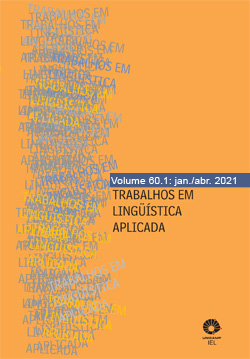Abstract
This article analyses the influences of representations or myths about what is to be a teacher in the (auto)perception of “digital native” teacher trainees in the face of practices using smartphone performed by them. Thus, it is discussed ways of understanding identities in post-modernity, placing it in the teacher education field. For this article, it is presented an excerpt from an ethnographic qualitative research that was developed in the context of an English teaching supervised internship, in which it was tried to use the smartphone. It was possible to observe how certain myths or representations of what it is to be a teacher may cause anguish and guilt in some teacher trainees due to the (im)position of a teacher identity considered to be the norm.
References
ALLWRIGHT, Dick (2003). Exploratory Practice: rethinking practitioner research in language teaching. Language Teaching Research, v. 7, n. 2, p. 113-141. https://doi.org/10.1191/1362168803lr118oa
ANDRÉ, Marli Eliza Dalmazo Afonso (2005). Etnografia da prática escolar. São Paulo: Papirus.
BARROS, Walter Vieira (2019). Letramentos digitais: um estudo com a mediação do smartphone no estágio supervisionado de língua inglesa no Ensino Médio. Dissertação de Mestrado em Linguagem e Ensino. Universidade Federal de Campina Grande, Campina Grande. Disponível em: http://dspace.sti.ufcg.edu.br:8080/jspui/handle/riufcg/6854 Acesso em: 10 maio 2020.
BARTON, David; LEE, Carmen (2015). Linguagem no mundo digital. In: ______. (Org.). Linguagem online: textos e práticas digitais. Tradução: Milton Camargo Mota. São Paulo: Parábola Editorial, p. 11-28.
BAUMAN, Zygmunt (2001). Modernidade líquida. Tradução Plínio Dentzien. Rio de Janeiro: Zahar.
BENWELL, Bethan; STOKOE, Elizabeth (2006). Discourse and identity. Edinburgh, UK: Edinburgh University Press.
BRITZMAN, Deborah P (2003). Practice makes practice: the given and the possible in teacher education. In: ______. Practice makes practice: a critical study of learning to teach. Albany: State University of New York Press, p. 221-241.
CORACINI, Maria José (2007). Pós-modernidade e novas tecnologias – no discurso do professor de línguas. In: ______. A celebração do outro: arquivo, memória e identidade: línguas (materna e estrangeira), plurilinguíssimo e tradução. Campinas, SP: Mercado das Letras, p. 200-224.
COSTA, Marco Antônio Margarido (2014). Reflexos das políticas itinerantes nas diretrizes curriculares nacionais dos cursos de letras. RBLA, Belo Horizonte, v. 14, n. 1, p. 41-60. https://doi.org/10.1590/S1984-63982013005000028
GIMENEZ, Telma (2011). Narrativa 14: Permanências e rupturas no ensino de inglês em contexto brasileiro. In: LIMA, Diógenes Cândido. (Org.). Ensinar inglês em escolas públicas não funciona? Uma questão, múltiplos olhares. São Paulo: Parábola Editorial, p. 47-54.
MARTINO, Luís Mauro Sá (2010). Comunicação e identidade. São Paulo: Paulus.
MATTOS, Andrea Machado de Almeida (2015). Reflexões sobre o uso de novas tecnologias e a formação de professores de inglês. Scitis, UNIP-SP, v. 3, p. 11-25.
MEDRADO, Betânia Passos; DOURADO, Maura Regina (2015). Uma proposta de transposição didática: a língua inglesa no ensino fundamental II. João Pessoa: Editora da UFPB.
MOITA LOPES, Luiz Paulo (2006). Uma linguística aplicada mestiça e ideológica: interrogando o campo linguista aplicado. In: ______. (Org.). Por uma linguística aplicada indisciplinar. São Paulo: Parábola Editorial, p. 13-44.
MORAN, José Manuel (2000). Ensino e aprendizagem inovadores com tecnologias audiovisuais e telemáticas. In: MORAN, José Manuel; MASETTO, Marcos T.; BEHRENS, Marilda Aparecida. (Org.). Novas tecnologias e mediação pedagógica. Campinas, SP: Papirus, p. 11-66.
MOREIRA, Herivelto; CALEFFE, Luiz Gonzaga (2008). Metodologia de pesquisa para o professor pesquisador. 2. ed. Rio de Janeiro: Lamparina.
PIMENTA, Selma Garrido (1997). Formação de professores: saberes da docência e identidade do professor. Nuances. v. 3, p. 5-14. https://doi.org/10.14572/nuances.v3i3.50
PIMENTA, Selma Garrido; ANASTASIOU, Léa das Graças Camargos (2002). O docente do ensino superior. In: PIMENTA, Selma Garrido; ANASTASIOU, Léa das Graças Camargos. (Org.). Docência no ensino superior. São Paulo: Cortez, p. 177-200.
PISCHETOLA, Magda (2016). Inclusão digital e educação: a nova cultura da sala de aula. Petrópolis: Editora Vozes; Rio de Janeiro: Editora PUC-Rio.
PRENSKY, Marc (2001). Digital natives, digital immigrants. On the Horizon, v. 9, n. 5, p, 1-6. https://doi.org/10.1108/10748120110424816
SILVA, Tomaz Tadeu (2014). A produção social da identidade e da diferença. In: ______. (Org.). Identidade e diferença: a perspectiva dos Estudos Culturais. 15. ed. Petrópolis, RJ: Vozes, p. 73-102.
WOODWARD, Kathryn (2014). Identidade e diferença: uma introdução teórica e conceitual. In: SILVA, Tomaz Tadeu (Org.). Identidade e diferença: a perspectiva dos Estudos Culturais. 15. ed. Petrópolis, RJ: Vozes, p. 7-72.

This work is licensed under a Creative Commons Attribution 4.0 International License.
Copyright (c) 2021 Trabalhos em Linguística Aplicada


